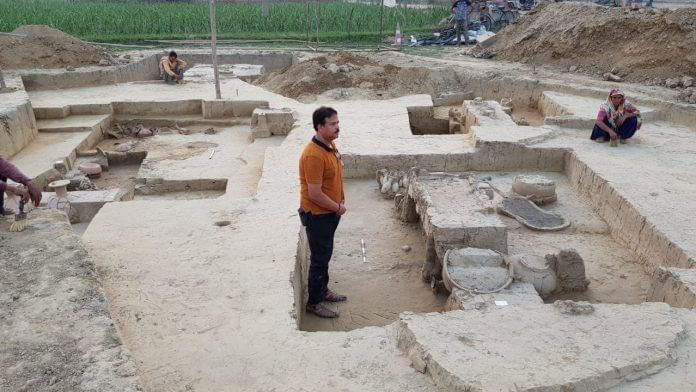In a recent interview, the Director General of the Archaeological Survey of India, YS Rawat, discussed reforms for the complete revival of the organisation’s excavation policies. He emphasised that while the agency’s work extends far beyond excavations, the true aim of any scientific dig should address the ‘civilisational questions’—those that link material findings to the holistic understanding of India’s past.
The suggestions likely draw inspiration from both the CAG report of 2013 and the Parliamentary Standing Committee report presented to the Rajya Sabha on 21 September 2023. The issues that the director general (DG) has recently highlighted—the context of the digs, the civilisation question, and the duration and continuity of excavation by individual archaeologists—echo many of the committee’s earlier observations.
However, the National Policy on Archaeological Excavation and Explorations, which was approved in 2015, illustrated the need for a change in research strategies in the light of changing landscape, practices and ethos. It mentioned the need for problem-oriented, long-term research projects covering various time periods. It also issued guidelines for undertaking explorations, especially pushing the state governments to take up village-to-village surveys to record sites within their jurisdictions.
Therefore, the issues that the DG now foregrounds are not new concerns but rather echoes of earlier directives that were never put into action. The issues, however, highlight a long-standing institutional inertia that warrants immediate action. The long-standing concerns have entered the administrative discourse again.
The implications, however, when viewed archaeologically, are reforms that revive the essential pursuit that has always guided excavation—the search for civilisational meaning. It asks not just why or how we dig, but who will and what face will define the archaeology of new India.
How long will the same people dig?
As per the new plan, the Archaeological Survey of India (ASI) hopes to give opportunities to new archaeologists who can provide a fresh perspective on iconic sites like Rakhigarhi in Hisar, Haryana. This was the primary reason for withholding the license for excavating Rakhigarhi this year. However, in 2021, when the archaeological site of Rakhigarhi was subjected to excavation for the ninth time after nearly five years, the excavator Sanjay Manjul was concerned with the civilisational questions, rather than the mere exposition of structure.
After being excavated for nine times by two eminent and experienced archaeologists—Amrendra Nath and Vasant Shinde—the site was again subjected to excavation to fill the gaps that existed in earlier research. The lack of published data from previous excavations and the sheer scale of the site presented a new opportunity for Manjul and his team to understand the settlement pattern of the site, to date the site, to understand the water management, and to conduct Remote sensing, LiDAR and other studies.
In the next two seasons, RGR 3—a mound at Rakhigari that had remained untouched—was excavated. It revealed a structural plan, a proper drainage system, a probable stadium, and a water tank. However, at the end of the third season, when the team was evaluating the possibility of the stadium and tank, the license was not renewed, citing a new policy.
Though there is no denying the importance of a fresh perspective, there is also no denying that big projects require being spearheaded by one investigator. Sites like Dholavira, Vadnagar, and Lothal were completely excavated only when one investigator and his team operated at the site for nearly a decade. In the West, Ian Hodder excavated Catalhoyuk in Turkey. In Nepal, Robin Cunnigham spearheads the Lumbini and Tilaurakot excavation.
Also read: Cambodia isn’t ready for India’s tigers. It doesn’t have prey or protection for big cats
The civilisational question
In 1965, the Indian government appointed a Review Committee to evaluate the functioning of the ASI and to propose measures for its development over the following five years. The committee, chaired by Mortimer Wheeler, included Niharranjan Ray, HD Sankalia, as well as Nurul Hasan as members, and made a report which came to be known as the ‘Wheeler Report’.
About 21 recommendations were made, which focused on expansion of staff, strengthening collaboration with universities and state departments, reorganising the ASI, refining exploration as well as excavation policies and incorporating scientific methods with improved documentation. The committee emphasised the need for balanced archaeological work, with focussing more on unexplored areas. The committee also emphasised regular reviews of the performance of ASI.
Over the years, however, only a handful of recommendations have been effectively implemented, which included the focus of archaeologists on the gap in the stratigraphical history of India. For decades, unknown or underrated areas were explored and sites were excavated. Yet gradually, the deeper question of why we dig began to blur, and the politicisation of archaeology came to overshadow the civilisational curiosity that had once defined it.
Even today, the imbalance persists. Certain regions of the country—particularly Bihar and West Bengal—still demand considerable attention. Sites like Rajgir, the first capital of the Magadhan empire, deserve renewed excavation. At the same time, the works undertaken by individual scholars and universities in these lesser-studied regions should be systematically reviewed to address the civilisational question, as alluded to by the committee reports.
The ongoing dialogue on the ASI’s excavation policy underscores a pivotal moment for archaeology in India, where institutional reforms intersect with the enduring quest to decode the nation’s civilisational heritage. While welcoming the introduction of fresh perspectives and structured planning, it is equally vital to recognise the importance of continuity and sustained leadership in large-scale, long-term excavations, as exemplified by landmark projects both in India and internationally.
Addressing persistent challenges—strategic prioritisation of sites, transparent documentation, and regional inclusivity—offers a chance to rejuvenate the ASI’s mandate. Ultimately, these reforms must balance innovation with experience, ensuring that excavations do not merely unearth artefacts but construct coherent narratives that illuminate India’s rich historical and cultural legacy, defining the archaeology of a ‘New India.’
Disha Ahluwalia is an archaeologist and research fellow at the Indian Council Of Historical Research. Views are personal. She tweets @ahluwaliadisha.
(Edited by Saptak Datta)






